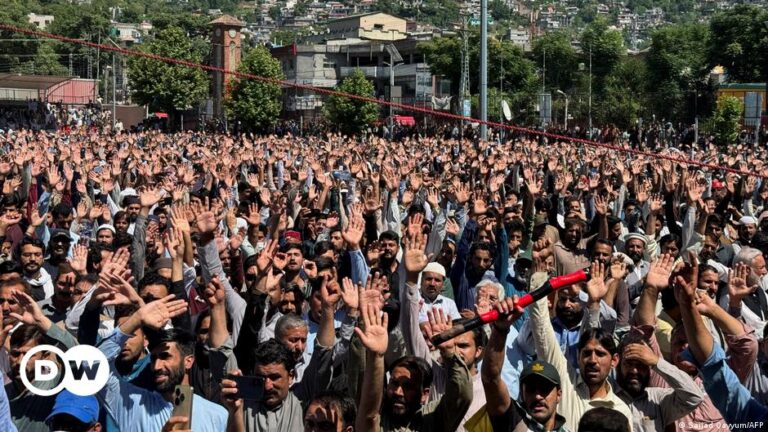Activists in Pakistan-administered Kashmir say recent protests over soaring food and energy prices reflect a larger issue involving the semi-autonomous region’s local government and the central government in Islamabad.
On Monday night, a paramilitary group called Rangers responded to protests in the regional capital Muzaffarabad, killing four people, including a police officer. An estimated 100 people were injured.
Authorities also suspended internet services and closed schools in response to the violence.
In response, Pakistani Prime Minister Shehbaz Sharif on Tuesday approved grants worth $82 million (75 million euros) to defuse the situation by partially meeting the demands of protesters.
Chaudhry Anwar-ul-Haq, head of the semi-autonomous government, said the funds will be used to significantly reduce the prices of flour and electricity.
Akhter Ali, a fruit seller in Muzaffarabad, told DW that this week’s violence in the region was “unprecedented.”
“This huge public outcry was necessary because the spike in inflation was intolerable,” he said.
Shaukat Nawaz Mir, chairman of the Jammu and Kashmir Joint Awami Action Committee (JAAC), the civil society organization that staged the protest, said the local government was “incompetent” and had “miserably failed to serve the people”. He told DW.
He added that after the federal government intervenes, JAAC also wants the Muzaffarabad government to “invest in its people”.
Long history of tensions in Kashmir
Greater tensions in Pakistan-administered Kashmir center on the region’s legal status as semi-autonomous. The region has a strong tradition and sense of identity separate from Pakistan.
Since the end of British colonial rule and the partition of India in 1947, life in the Kashmir Valley has been shaped by the conflict between India and Pakistan. The region is claimed entirely by both countries, but is partially controlled by both countries. This situation as a conflict zone greatly hinders investment in the local economy.
Indian-administered Kashmir maintained semi-autonomous status until 2019, but New Delhi took away the guarantees provided in Article 370 of the constitution and took direct control of the region.
Pakistan-administered Kashmir, locally known as Azad Jammu and Kashmir, is run by a semi-autonomous government with its capital in Muzaffarabad. The territory of 4 million people has its own parliament and prime minister.
However, many believe this semi-autonomy only exists on paper and consider the semi-autonomous government to be a “puppet” of Islamabad.
This sentiment has intensified in recent days, with activists accusing the Islamabad government of a conspiracy to exploit the region’s resources without providing any local benefits and contributing to the economic crisis.
“These protests are a continuation of a year-long movement to restore fundamental rights and end resource exploitation by Islamabad and its puppets in the occupied territories,” said Tokir of the activist group Jammu and Kashmir Liberation Front (JKLF).・Representative Gilani stated. he told DW.
However, internal protests in the region have generally not reached the level of violence seen this week.
Dissatisfaction with the central government in Islamabad
The unrest began on Friday evening after a group of traders went on strike in Muzaffarabad and ended up clashing with police forces.
But activists have been demanding more action from local governments to address rising food and energy prices for at least a year.
One of the demands includes lower electricity bills, given that electricity is generated locally by the hydroelectric Mangla Dam in Pakistan-administered Kashmir.
Activists say these long-standing grievances have allowed the protests to quickly gain momentum and garner significant support from all segments of society, especially those who are increasingly lacking access to food and energy. He said he was able to do it.
Activist leader Gilani said: “Intolerable and illegal taxation due to rising prices of food and electricity, the removal of subsidies on flour, and the misuse of public funds by politicians and bureaucratic elites have undermined this massive rights movement.” I caused it,” he said.
Seek behavior change
The economic woes facing Pakistan-administered Kashmir are mirrored as Pakistan grapples with its own ongoing financial crisis. Activists blame Islamabad’s mismanagement and interference for exacerbating Kashmir’s economic problems.
Kashmiri activist Gilani said locals were starting to “understand” that “actually, Islamabad is to blame for all the misery”, adding that the recent protests are part of a mass movement demanding a change in Pakistan’s behavior. He added that he had started. [military] Established.
“All residents of Azad Kashmir are dissatisfied with the plunder of resources by the Pakistani establishment, mismanagement, poor infrastructure and Islamabad’s dubious role in the 77-year inhumane occupation of the region by India and Pakistan. “There is,” he said.
Pakistani Prime Minister Sharif called the protests “alarming” and said some protesters wanted to destabilize the region.
“To be sure, there were individuals among those driving this movement who were fulfilling their duties in a democratic manner under legitimate demands. There is no denying that there were malicious elements who wanted to ‘create chaos in Azad Jammu and Kashmir,”’ the prime minister said during a visit to the region on Thursday.
Maliha Lodhi, Pakistan’s former representative to the United Nations, told DW that the protests and economic crisis are part of a larger problem for the Pakistani government and its perceived role in the daily lives of Kashmiris. Told.
“The cost of living crisis is impacting people from all parts of the region. Public anger is directed at the Islamabad government, which is expected to ease the economic plight of the people,” Lodhi said. Stated.
Editor: Wesley Rahn

